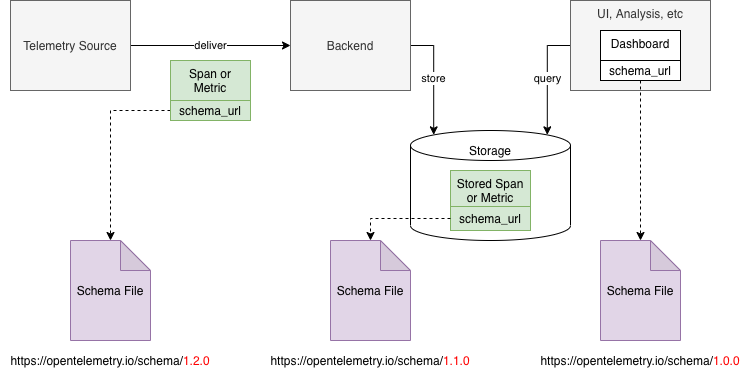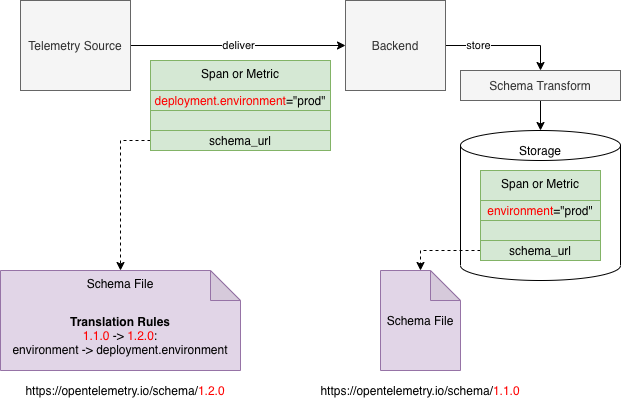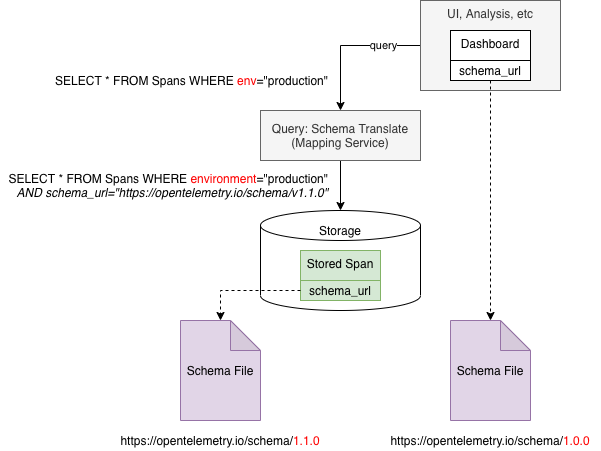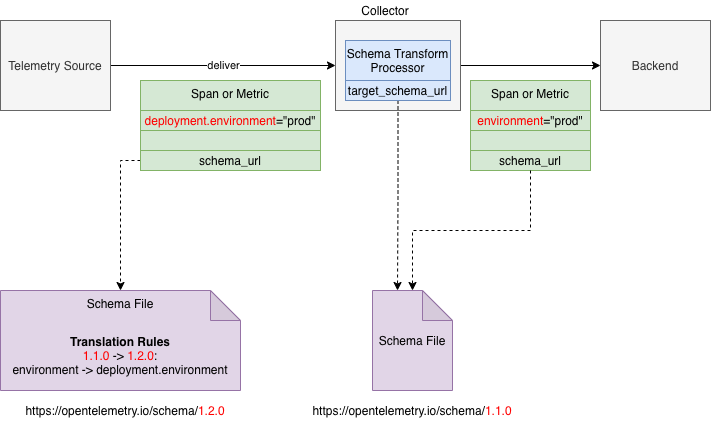Telemetry Schemas
Status: Stable
Motivation
Telemetry sources such as instrumented applications and consumers of telemetry such as observability backends sometimes make implicit assumptions about the emitted telemetry. They assume that the telemetry will contain certain attributes or otherwise have a certain shape and composition of data (this is referred to as “telemetry schema” throughout this document).
This makes it difficult or impossible to change the composition of the emitted telemetry data without breaking the consumers. For example changing the name of an attribute of a span created by an instrumentation library can break the backend if the backend expects to find that attribute by its name.
Semantic conventions are an important part of this problem. These conventions define what names and values to use for span attributes, metric names and other fields. If semantic conventions are changed the existing implementations (telemetry source or consumers) need to be also changed correspondingly. Furthermore, to make things worse, the implementations of telemetry sources and implementations of telemetry consumers that work together and that depend on the changed semantic convention need to be changed simultaneously, otherwise such implementations will no longer work correctly together.
Essentially there is a coupling between 3 parties: 1) OpenTelemetry semantic conventions, 2) telemetry sources and 3) telemetry consumers. The coupling complicates the independent evolution of these 3 parties.
We recognize the following needs:
OpenTelemetry semantic conventions need to evolve over time. When conventions are first defined, mistakes are possible and we may want to fix the mistakes over time. We may also want to change conventions to re-group the attributes into different namespaces as our understanding of the attribute taxonomy improves.
Telemetry sources over time may want to change the schema of the telemetry they emit. This may be because for example the semantic conventions evolved and we want to make our telemetry match the newly introduced conventions.
In an observability system there may simultaneously exist telemetry sources that produce data that conforms to different telemetry schemas because different sources evolve at a different pace and are implemented and controlled by different entities.
Telemetry consumers have a need to understand what schema a particular piece of received telemetry confirms to. The consumers also need a way to be able to interpret the telemetry data that uses different telemetry schemas.
Telemetry Schemas that were proposed and accepted in OTEP0152 address these needs.
How Schemas Work
We believe that the 3 parties described above are able to evolve independently over time, while continuously retaining the ability to correctly work together.
Telemetry Schemas are central to how we make this possible. Here is a summary of how the schemas work:
OpenTelemetry defines a file format for defining telemetry schemas.
Telemetry schemas are versioned. Over time the schema may evolve and telemetry sources may emit data conforming to newer versions of the schema.
Telemetry schemas explicitly define transformations that are necessary to convert telemetry data between different versions of the schema, provided that such conversions are possible. When conversions are not possible it constitutes a breaking change between versions.
Telemetry schemas are identified by Schema URLs, that are unique for each schema version.
Telemetry sources (e.g. instrumentation libraries) will include a schema URL in the emitted telemetry.
Telemetry consumers will pay attention to the schema of the received telemetry. If necessary, telemetry consumers may transform the telemetry data from the received schema version to the target schema version as expected at the point of use (e.g. a dashboard may define which schema version it expects).
OpenTelemetry publishes a telemetry schema as part of the specification. The schema contains the list of transformations that semantic conventions undergo. The schema is to be available, to be referred and downloaded at a well known URL:
/schemas/<version>(where<version>matches the specification version number).OpenTelemetry instrumentation libraries include the OpenTelemetry Schema URL in all emitted telemetry. This is currently work-in-progress, here is an example of how it is done in Go SDK’s Resource detectors.
OTLP allows inclusion of a schema URL in the emitted telemetry.
Third-party libraries, instrumentation or applications are advised to define and publish their own telemetry schema if it is completely different from OpenTelemetry schema (or use OpenTelemetry schema) and include the schema URL in the emitted telemetry.
What is Out of Scope
The concept of schema does not attempt to fully describe the shape of telemetry. The schema for example does not define all possible valid values for attributes or expected data types for metrics, etc. It is not a goal. Our goal is narrowly defined to solve the following problem only: to allow OpenTelemetry Semantic Conventions to evolve over time. For that reason this document is concerned with changes to the schema as opposed to the full state of the schema. We do not preclude this though: the schema file format is extensible and in the future may allow defining the full state of the schema.
We intentionally limit the types of transformations of schemas to the bare minimum that is necessary to handle the most common changes that we believe OpenTelemetry Semantic Conventions will require in the near future. More types of transformations may be proposed in the future. This proposal does not attempt to support a comprehensive set of possible transformation types that can handle all possible changes to schemas that we can imagine. That would be too complicated and very likely superfluous. Any new transformation types MUST be proposed and added in the future to the schema file format when there is an evidence that they are necessary for the evolution of OpenTelemetry.
Use Cases
This section shows a couple interesting use-cases for the telemetry schemas (other uses-cases are also possible, this is not an exhaustive list).
Full Schema-Aware
Here is an example on a schema-aware observability system:

Let’s have a closer look at what happens with the Telemetry Source and Backend pair as the telemetry data is emitted, delivered and stored:

In this example the telemetry source produces spans that comply with version 1.2.0 of OpenTelemetry schema, where the “deployment.environment” attribute is used to record that the span is coming from production.
The telemetry consumer desires to store the telemetry in version 1.1.0 of OpenTelemetry schema. The schema translator compares the schema_url in the received span with the desired schema and sees that a version conversion is needed. It then applies the change that is described in the schema file and renames the attribute from “deployment.environment” to “environment” before storing the span.
And here is for example how the schemas can be used to query stored data:

Collector-Assisted Schema Transformation
Here is a somewhat different use case, where the backend is not aware of schemas and we rely on OpenTelemetry Collector to translate the telemetry to a schema that the backend expects to receive. The “Schema Translate Processor” is configured, the target schema_url is specified and all telemetry data that passes through the Collector is converted to that target schema:

Schema URL
Schema URL is an identifier of a Schema. The URL specifies a location of a Schema File that can be retrieved (so it is a URL and not just a URI) using HTTP or HTTPS protocol.
Fetching the specified URL may return an HTTP redirect status code. The fetcher MUST follow the HTTP standard and honour the redirect response and fetch the file from the redirected URL.
The last part of the URL path is the version number of the schema.
http[s]://server[:port]/path/<version>
The part of the URL preceding the <version> is called Schema Family
identifier. All schemas in one Schema Family have identical Schema Family
identifiers.
To create a new version of the schema copy the schema file for the last version in the schema family and add the definition of the new version. The schema file that corresponds to the new version MUST be retrievable at a new URL.
Important: schema files are immutable once they are published. Once the schema file is retrieved it is recommended to be cached permanently. Schema files may be also packaged at build time with the software that anticipates it may need the schema (e.g. the latest OpenTelemetry schema file can be packaged at build time with OpenTelemetry Collector’s schema translation processor).
Schema Version Number
Version number follows the MAJOR.MINOR.PATCH format, similar to semver 2.0.
Version numbers use the ordering rules defined by semver 2.0 specification. See how ordering is used in the Order of Transformations. Other than the ordering rules the schema version numbers do not carry any other semantic meaning.
OpenTelemetry schema version numbers match OpenTelemetry specification version numbers, see more details here.
OTLP Support
To allow carrying the Schema URL in emitted telemetry OTLP includes a schema_url field in the messages:
The schema_url field in the ResourceSpans, ResourceMetrics, ResourceLogs messages applies to the contained Resource, Span, SpanEvent, Metric, LogRecord messages.
The schema_url field in the InstrumentationLibrarySpans message applies to the contained Span and SpanEvent messages.
The schema_url field in the InstrumentationLibraryMetrics message applies to the contained Metric messages.
The schema_url field in the InstrumentationLibraryLogs message applies to the contained LogRecord messages.
If schema_url field is non-empty both in Resource* message and in the contained InstrumentationLibrary* message then the value in InstrumentationLibrary* message takes the precedence.
API Support
The OpenTelemetry API allows getting a Tracer/Meter that is associated with a Schema URL.
OpenTelemetry Schema
OpenTelemetry publishes it own schema at opentelemetry.io/schemas/<version>. The version number of the schema is the same as the specification version number which publishes the schema. Every time a new specification version is released a corresponding new schema MUST be released simultaneously. If the specification release did not introduce any change the “changes” section of the corresponding version in the schema file will be empty.
Feedback
Was this page helpful?
Thank you. Your feedback is appreciated!
Please let us know how we can improve this page. Your feedback is appreciated!